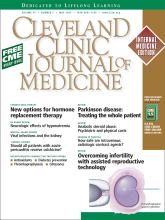Imaging in Practice
Intravenous iodinated contrast agents: Risks and problematic situations
Kimmie L. Bui, MD, Joseph D. Horner, DO, Brian R. Herts, MD and David M. Einstein, MD
Cleveland Clinic Journal of Medicine May 2007, 74 (5) 361-367;
Kimmie L. Bui
Department of Diagnostic Radiology, Cleveland Clinic
Joseph D. Horner
Department of Diagnostic Radiology, Cleveland Clinic
Brian R. Herts
Associate professor of radiology, Cleveland Clinic Lerner College of Medicine; section head, Abdominal Imaging, Department of Diagnostic Radiology, Cleveland Clinic
David M. Einstein
Program director, Radiology Residency Program, Department of Diagnostic Radiology, Cleveland Clinic

ABSTRACT
Many of today’s diagnostic imaging studies use intravenous contrast media to adequately evaluate disease processes. Although these agents are generally safe, their use poses some risks and, in some situations, is problematic. The risks include contrast-induced nephropathy.
- Copyright © 2007 The Cleveland Clinic Foundation. All Rights Reserved.
In this issue
Cleveland Clinic Journal of Medicine
Vol. 74, Issue 5
1 May 2007
Intravenous iodinated contrast agents: Risks and problematic situations
Kimmie L. Bui, Joseph D. Horner, Brian R. Herts, David M. Einstein
Cleveland Clinic Journal of Medicine May 2007, 74 (5) 361-367;
Jump to section
Related Articles
- No related articles found.
Cited By...
- Chronic Kidney Disease Progression and Cardiovascular Outcomes Following Cardiac Catheterization--A Population-Controlled Study
- Contemporary Incidence, Predictors, and Outcomes of Acute Kidney Injury in Patients Undergoing Percutaneous Coronary Interventions: Insights From the NCDR Cath-PCI Registry
- How do centres begin the process to prevent contrast-induced acute kidney injury: a report from a new regional collaborative
- Sodium Bicarbonate Plus N-Acetylcysteine Prophylaxis: A Meta-Analysis





